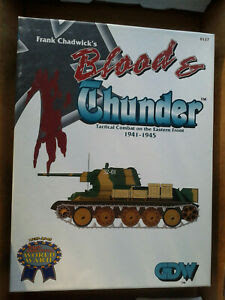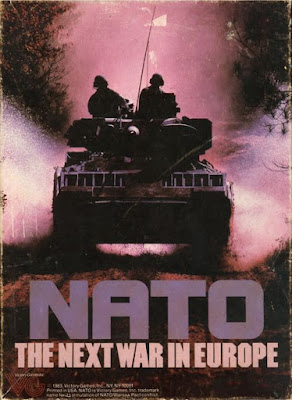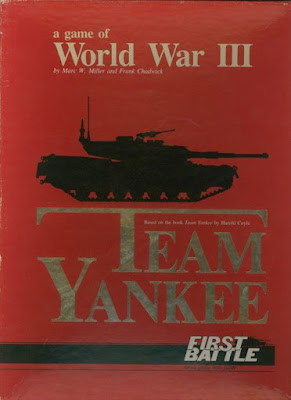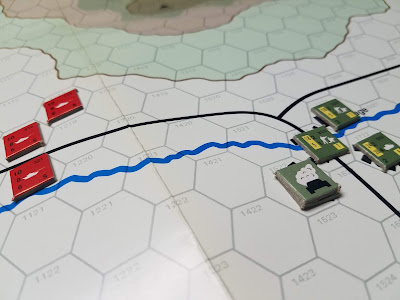Everyone knows I love to travel down rabbit holes when it comes to wargaming. Once recent sojourn into the world of retro board wargames turned into a delightful, albeit expensive, trip down memory lane....
Enter the now-defunct GDW's range of games from the "First Battle" series. The concept behind "First Battle" was simple - produce a series of "quick play" games that had common elements in rules and presentation that could serve as a "First Battle" for someone getting into wargaming, and also had enough advanced features to appeal to seasoned wargamers.
The final "First Battle" games of the series upgraded unit size to platoons from squads and individual vehicles, and introduced some of the concepts you now see in Command Decision such as command and staff units, and orders transmission - so the systems seem to be related, sort of. Perhaps related in that they came from the brilliant mind of Frank Chadwick, but there are similarities.
 |
| One of the final games of the system, B&T established platoons as the basic unit of maneuver in First Battle instead of individual vehicles and squads/teams |
Anyways, this led to a buying binge of GDW games off Ebay, including a my third purchase of GDW's 1987 "Team Yankee" (I had sold or given away my last 2 copies), "Test of Arms", "Sands of War", "Stand & Die" [the First Battle "Flagship" if you ask me], and luckily for my wallet, I already owned "Blood and Thunder" which covers the entire Eastern Front of WWII.
I bought these rules because I had always wanted to own them, ever since the days when I was a snobby, operational level gaming 7th grader, who thumbed his nose at "boring" tactical simulations in favor of huge 10 mile hex maps of Central Europe featured on Victory Games' NATO: The Next War in Europe. (it would be 2 years until I discovered John Hill's Squad Leader and PanzerBlitz, both life changing events)
 |
| The box art oozes authenticity. The intensity of a Bradley crew tearing across a river ford near Bad Hersfeld... |
Anyways, the GDW games on the shelf in CAPS' COMIC CAVALCADE in Bethlehem, Pennsylvania had all of the GDW titles, and the artwork on the box of Battlefield: Europe made me want to buy them. All of them! Alas. When you're a 7th grader you never had alot of money at any given time so I took what I could get. In a choice between the 30 dollar "NATO" or the 30 dollar "Battlefield Europe", I chose NATO. That's been remedied now to the chagrin of my wife but at least the titles are on the shelf. This did set back my huge Russian 10mm Eylau purchase but there is next month!
 |
| Still one of my favorite box art pieces to this day - and I dont even own it! |
Fast forward to 2022. I'm a time-strapped, 40-something family man with a headful of wargame projects and not enough time to accomplish them all. My plan is to play some of these games out with minis on the hex board to see how it feels but I first wanted to learn the rules again - which is exactly what we're going to get into next! There are posts out there abound with gamers using PanzerBlitz and PanzerLeader counters but using the First Battle sequence of play and system. Could "First Battle" be my answer to big battles with minis and hexes? Read on to find out!
Scenario 1: To the Rescue!
It's World War III set in 1985. Central Europe - West Germany. An American Cavalry Section in M3 Bradleys with their dismounts are holding a forward village and they're under attack. Soviet forward elements in T-72s and BMP-1s are bearing down on them, and 2 x M1's are hastily coming to reinforce. Let's see what happens.
The Soviets are the "attacker" and have the initiative. They can select whether they want to move first or second, each turn! Yes you are correct- they could chose to go second this turn, and first next turn. Which is precisely what they do! The Americans must adjust their positions and dismount their dismounts, so they cannot take up a "firing position" which would have enabled them to fire during the Soviet move (think of it like overwatch-if you dont move this turn you can fire during the enemy's move).
Turn 1
The "final attack phase" of Turn 1 sees the Soviets fire 2 x T-72s at the Bradley in the western end of the village. The first shot damages the M3.
The second shot from the next T-72 destroys it. The American platoon commander is sweating. The next T-72 declared it was firing at the dismounts in the village. They score a pin and end a very impressive round of shooting for Ivan.
Turn 2
The Soviets move first. The BMPs ford the small creek and attempt to flank the village. Instead of keeping any kind of cohesion between platoons, I send a T-72 with one of the BMPs, and a BMP with one of the T-72s. I'm thinking a few turns ahead and it doesn't look good for the Americans.
 |
| Pinned US troops in the village and a destroyed Bradley burns while the Soviet flanking force crashes south of the ford. |
 |
| missile shot from the infantry team in the village takes out a T-72 next to the creek. |
 |
| The M1s with their 8 hex movement tear up the road from the south and engage the Soviets. A T-72 is damaged (eventually destroyed), and a BMP-1 is destroyed. |
Turn 3 - 5
The Soviets, now with the arrival of 2 M1s on the battlefield, get serious. They take the first turn and try to turn the tables on the M1s. An extremely lucky shot from the BMP-1's AT-3 missile destroys one of the M1s. Soviet dismounts survive from the destruction of their IFV (they roll a 1-3 successfully). To the north, the Soviet fixing force creeps into the village and mixes it up with the Bradley and remaining US dismounts, finishing them off with a ton of "1"s rolled (rolling low is good in First Battle). The Soviets have control of the bridge and have a T-72 and an infantry dismount team in the middle of the village. The remaining US M1 pulls out. Game is over in 5 turns.
All due to bad positioning and potentially bad decision making (moving both of the Bradleys on the first turn instead of firing with one bradley while the other one dismounted, essentially the "wingman" bradley covering his battle buddy while it dismounted. This is all painfully realistic)
 |
| "Look at this, Codman. I love it. God help me I do love it so." |
Analysis
This was a great game. Lots of fun and hard decision making. You start to see how you can use the turn sequence to your advantage with the Fire-Move-Final Fire sequence. The game rewards "softening up" an objective with fire, as well as fire and movement, and covering fire. The old adage of "if it can be seen, it can be hit, if it can be hit, it can be killed" rings true.
If the Americans would have deployed better, they could have placed their Bradleys in "firing positions" with Overwatch and likely knocked out a vehicle or 2 on the way in. Something interesting to consider? Look at all the knocked out vehicle carcasses. Probably not far from how a WWIII scenario would have played out in such close quarters.
NATO's edge in this game were the M1s and the reach and lethality of the TOW missiles. Other than that, a Soviet infantry team is similar to an American one, and a T-72's gun is deadly at close range, doubling itself to a "20". All sounds pretty logical and the First Battle System racked up an impressive and evocative game.
The Transition to Minis?
How does all this bode for transition to a minis game? Actually pretty well - with caveats. The game has been "dead simple" so far, and very fast. This game played in about 30 minutes with most of that time taken up with me reading the rules. Overall it has great potential to be played with minis - but is it as simple as just plopping the microarmor down and using tanks instead of counters? Not so fast!
The use of a combat results table is limiting. Meaning that with a CRT, it doesn't feel like a miniatures game, it feels like a rendition of PanzerBlitz or PanzerLeader. For the cousins "Sands of War" or "Blood and Thunder" where a counter/stand = a platoon that is probably more appropriate, but when a counter is a vehicle, I want a "to hit" / "to kill" roll which is greatly abstracted here.
I'm not knocking the system mind you. This entire game felt genuine. The lethality of modern systems is the ultimate lesson. So the abstraction enables you to put the huge battles from the end of the "Team Yankee" book onto a table and play it in a reasonable amount of time. That said, if you want to play it with miniatures and you want it to feel a little more like a miniatures game, you might want to consider some things. So what might those be?
Terrain for starters. You'll need terrain, smaller terrain to fit into the hexes. Lichen, clump foliage and trees will be needed to capture the feel of a miniatures game as well. Same thing with hills. Team Yankee and the other First Battle games have lots of elevation differences. Since the caveman days, man has been trying to figure out how to model functional and cool looking hills for hex games on the tabletop. Something to consider.
Something else to consider is creating a QRS so you're not flipping constantly through the rules. There aren't many rules, but much text has been put onto about 8 pages of rules and you'll be going back and forth quite a bit.
The initiative seems a bit generous and powerful. I'd probably introduce a random initiative roll each turn, but I dont see how that would impact playing with minis. I'd also add in random events and/or a time clock like in Norm's "Tigers at Minsk" which adds a wonderful tension and uncertainty to the entire game.
Finally the Combat Results Table. While I love the idea that the to-hit and to-kill process is abstracted into a single die roll on a table, and that a counter has all of the self-contained information you could want, with values assigned to armor, gun attack, movement, and gun / missile range, I'd love to take that data and translate it back into a "To Hit" "To Kill" roll. Mathematically that's possible but I'm not a mathematician and so it will take much time and energy for a dummkopf like me to convert the values of the weapons and armor, along with the probability of hitting and probability of killing vrs damaging AFVs. That equally applies to pinning vrs killing infantry teams.
Other than these "considerations" the Team Yankee game from the First Battle series is shovel ready. So if you really like the GDW "Team Yankee" board game, it's ready for you to plop your minis down with maybe the counters behind or under them, and play. If you want it to feel a bit more like a miniatures game while still using the stats, scenarios, and turn sequence, you'll need to do a bit of homework.
This was a very fun and satisfying exercise and I'm looking forward to playing Sands of War with my Western Desert WWII MicroArmor or Desert Storm kit (fancy a fictitious Soviet Airborne assault into Saudi Arabia? - you could do it with the SoW rules).
If you liked this post, definitely stay tuned because I'm participating in a similar "experiment" tomorrow with Ken using a slightly more modern WWIII board game for potential use as a minis game on hexes. The experiment continues!
Also a special BONUS feature - my blog has had a commenter named "Mitch" who has been patiently waiting for a number of years for me to complete the Dunn-Kempf project. Rather than complete a second blog post below this one, I'm linking to the post from a number of years ago where we unveiled our aspirations to play Dunn-Kempf and I'm going to put a game on the table for Mitch. I completed an entire T-62 tank battalion, BMP-1 company, and supporting arms like artillery and recon, as well as the Americans with the older MTOEs (M60 tanks, M113 APCs) , to play a game of Dunn Kempf from the roaring 70s. I even painted them in MERDC. Sadly, I've never gamed with them! So stay tuned everyone. Mitch, your wait won't be much longer now! This is the year!




















